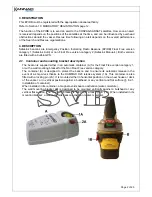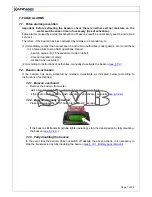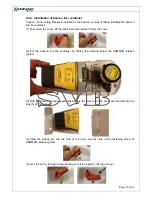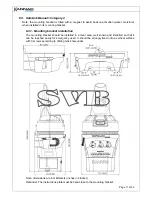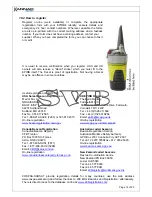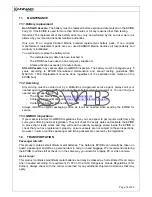
Page 1 of 25
1. INTRODUCTION
1.1. COSPAS-SARSAT system description
COSPAS-SARSAT is a global distress warning system operating in the 406.0 - 406.1 MHz
frequency band. The 406 MHz frequency coded with the beacon ID, is used to determine the
position of the beacon to alert the nearest Search and Rescue Services (S.A.R.).
The system consists of:
1. Distress
beacons;
2. Satellites on polar orbits (LEOSAR) and geostationary satellites (GEOSAR);
3. Local User Terminals (LUTs);
4. Mission and Rescue Control Centers (MRCC's).
5. MCCs receive alerts produced by LUTs and forward them to Rescue Coordination
Centers (RCCs) or Search
6. and Rescue (S.A.R.) Points Of Contacts
Figure 1: Cospas-Sarsat System
1.2. Immediate alerting and location calculation
When activated, the SafeLink beacons transmit, in the 406 MHz frequency, a coded message with
a unique number to identify the distress and the beacon’s owner, and the GPS position. This
message is picked up by the COSPASSARSAT satellites which store it and continuously
retransmit it to the Local User Terminals (L.U.T) Thanks to the geostationary satellites (GEOSAR),
the distress is received within minutes and transmitted anywhere in the world.
Thanks to the orbital satellites (LEOSAR), the position of the distress is calculated within one
nautical mile anywhere in the world using Doppler techniques. The typical waiting time for
calculating a position in average latitudes is less than one hour.
Thanks to the built-in GPS receiver
, its position (accuracy typically about 120 meters) will be
transmitted by the beacon within minutes following the distress.
The data are processed and retransmitted to Mission and Rescue Control Centers (MRCC's) and
to the Search And Rescue Center (RCC or S.A.R.) nearest to the distress to organize the rescue
operations.
The 121.5 MHz frequency is also transmitted by the beacon and is used as a homing frequency in
the final stages of rescue.
2. APPLICATION
This EPIRB (Emergency Position Indicating Radio Beacon) is designed for use in maritime
emergencies, and is approved for these contingencies.
It is not designed or recommended for use on land or in the air.
Use the EPIRB only in situations of grave and imminent danger. Intentional false alerts may result in
penalties.
Содержание SafeLink EPIRB
Страница 1: ...SAFELINK EPIRB User Manual ...
Страница 2: ...SafeLink Category 1 ...
Страница 3: ...SafeLink Category 2 ...
Страница 9: ...Page 4 of 25 ...
Страница 25: ...Page 20 of 25 ...
Страница 28: ...Page 23 of 25 RELEASE SYSTEM REMPLACEMENT Date Signature Next remplacement ...
Страница 31: ......







